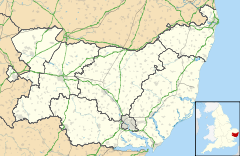- Hoxne
-
Coordinates: 52°21′N 1°12′E / 52.35°N 1.2°E
Hoxne 
Village Hall, Hoxne
 Hoxne shown within Suffolk
Hoxne shown within SuffolkDistrict Mid Suffolk Shire county Suffolk Region East Country England Sovereign state United Kingdom Post town EYE Postcode district IP21 EU Parliament East of England List of places: UK • England • Suffolk Hoxne (
 /ˈhɒksən/) is an anciently established village in the Mid Suffolk district of Suffolk, England, about five miles (8 km) east-southeast of Diss, Norfolk and one-half mile (800 m) south of the River Waveney. The parish is irregularly shaped, covering the villages of Hoxne, Cross Street and Heckfield Green, with a 'tongue' extending southwards to take in part of the former RAF Horham airfield.
/ˈhɒksən/) is an anciently established village in the Mid Suffolk district of Suffolk, England, about five miles (8 km) east-southeast of Diss, Norfolk and one-half mile (800 m) south of the River Waveney. The parish is irregularly shaped, covering the villages of Hoxne, Cross Street and Heckfield Green, with a 'tongue' extending southwards to take in part of the former RAF Horham airfield.Contents
Overview
The area around the village is of archaeological note as the find-spot of the Hoxne Hoard of Roman treasure, very early finds of hand axes[1] and as the type site for the Hoxnian Stage ("Hoxnian interglacial").
The village is also home to The Swan Inn. The Swan occupies a 15th Century, Grade II listed lodge, formerly known as Bishops Lodge. This pub is set at the bottom end of the village green, opposite the village Post Office and grocery store, only a short walk from Saint Edmund's memorial and bridge. Built in 1480 by the Bishop of Norwich, The Swan has a long history; both the restaurant and bars reflect Hoxne's ecclesiastical past, with ornate ceiling beams and wide-planked floors.
John Frere [1740-1807] was the first person to recognise and write about the flint weapons discovered at Hoxne. He wrote a letter to the Society of Antiquaries, published in 1800, relating to the flints discovered within various strata within the site of an interglacial lake, part of the Hoxnian interglacial. John Frere was born at Westhorpe in Suffolk, but lived at Roydon Hall in Diss.
Legend
It is said that Saint Edmund, King of East Anglia, hid under the bridge known in those times as Gold Bridge to elude the pursuing Danes. A newly married couple saw the king's gold spurs and gave his location away to his enemies. According to the legend, Saint Edmund put a curse on all couples who cross the bridge on their way to get married.[2]
See also
- Hoxne (hundred)
- Hoxne manor
- Hoxne Priory
- Hoxne hoard
- Hoxnian Stage
References
- Stephen Govier (2006). The Illustrated History and Antiquities of Hoxne.
- John Frere (1797/1800). An Account of Flint Weapons.
- W.E. Bishop (1833). Views of Churches in the Hoxne Hundred.
- Betty Rutherford (1973). A Wheelwright of Hoxne.
- Nora Coleman. People Poverty and Protest.
- Margaret C Evans, illustrated by Stephen Govier. St Edmund and Hoxne.
- Stephen Govier (2007). An Illustrated History and Guide to Diss, Norfolk.
External links
Categories:- Villages in Suffolk
- Mid Suffolk
Wikimedia Foundation. 2010.

